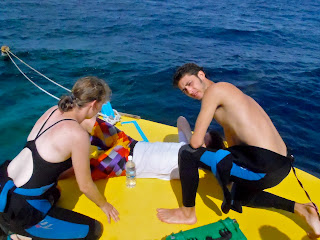Yes, that was Robyn and her classmates' introduction to the Rescue Diver course. You'll be glad to hear that they rescued us panic stricken DMTs (divemasters in training, if you've forgotten) without too much delay or hesitation, making good use of flotation devices which had been strategically placed on the dock ahead of time. Yes, welcome to the Rescue Diver course as taught by the Utila Dive Centre (UDC) and especially instructor Maya.
During a Rescue course, you learn and practice a lot of skills that can help you get yourself or others out of a potentially dangerous situation. While we do practice skills like surfacing an unresponsive diver, much of the value of the course lies in learning to look for warning signs and prevent problems before they happen. Most fatal diving accidents occur when a minor problem, such as a flooded mask, causes a diver to panic, escalating the problem into a situation which causes major injury, such as an uncontrolled ascent while holding a breath resulting in an air embolism. As such, much of the Rescue course is scenario based--practicing these skills over and over again until they become automatic.
The role of the DMTs on such a course is awesome. While we helped with demos of skills (where we ended up with amazing instructions such as the one in the title), most of our job was to keep the students constantly on the alert. For instance, when a diver wasn't currently practicing a skill, we would swim over and begin a panicked ascent forcing them to analyze whether we were overexerted or out of air and respond appropriately. Or, on the surface, while a couple others worked with Maya on how to approach a panicked diver on the surface, one of us would quietly go unresponsive and see how long it took them to notice and respond. The results of this, other than helping teach, of course, are that the ocean is now short several gallons, thanks to our open mouths as we drowned repeatedly.
 |
| Robyn rescues Nikki. |
 |
| Mike and Robyn work on saving a drowning DMT. |
 |
| Nicholas and Robyn practice buddy breathing. |
 |
| Robyn and Nicholas work on an EFR scenario on DMT Joe. |
 |
| Robyn surfaces an unresponsive DMT. |
I suspected Maya was a barrel of laughs, in a twisted, warped way.
ReplyDelete